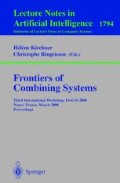Abstract
We define a sound and complete logic, called \({\cal FO}^{\supset}\), which extends classical first-order predicate logic with intuitionistic implication.
As expected, to allow the interpretation of intuitionistic implication, the semantics of \({\cal FO}^{\supset}\) is based on structures over a partially ordered set of worlds. In these structures, classical quantifiers and connectives (in particular, implication) are interpreted within one (involved) world. Consequently, the forcing relation between worlds and formulas, becomes non-monotonic with respect to the ordering on worlds. We study the effect of this lack of monotonicity in order to define the satisfaction relation and the logical consequence relation which it induces.
With regard to proof systems for \({\cal FO}^{\supset}\), we follow Gentzen’s approach of sequent calculi (cf.[8]). However, to deal with the two different implications simultaneously, the sequent notion needs to be more structured than the traditional one. Specifically, in our approach, the antecedent is structured as a sequence of sets of formulas. We study how inference rules preserve soundness, defining a structured notion of logical consequence. Then, we give some general sufficient conditions for the completeness of this kind of sequent calculi and also provide a sound calculus which satisfies these conditions. By means of these two steps, the completeness of \({\cal FO}^{\supset}\) is proved in full detail. The proof follows Hintikka’s set approach (cf. [11]), however, we define a more general procedure, called back-saturation, to saturate a set with respect to a sequence of sets.
This work has been partially supported by project TIC98-0949-C02-02.
Access this chapter
Tax calculation will be finalised at checkout
Purchases are for personal use only
Preview
Unable to display preview. Download preview PDF.
References
Arruabarrena, R., Lucio, P., Navarro, M.: A Strong Logic Programming View for Static Embedded Implications. In: Thomas, W. (ed.) FOSSACS 1999. LNCS, vol. 1578, pp. 56–72. Springer, Heidelberg (1999)
Farinas, L., Herzig, A.: Combining classical and intuitionistic logic, or: intuitionistic implication as a conditional. In: Baader, F., Schulz, K.U. (eds.) Frontiers in Combining Systems (Proc. Int. Workshop FroCos 1996). Applied Logic Series, pp. 93–102. Kluwer Academic Publisher, Dordrecht (1996)
Fitting, M.: Proof Methods for Modal and Intuitionistic Logics. D. Reidel Publishing Company, Dordrechtz (1983)
Fitting, M.: Basic Modal Logic. In: Gabbay, D.M., Hogger, C.J., Robinson, J.A. (eds.) Handbook of Logic in Artificial Intelligence and Logic Programming, vol. 1, pp. 365–448. Oxford University Press, Oxford (1993)
Gabbay, D.M.: Labelled Deductive Systems, vol. 1. Oxford University Press, Oxford (1996)
Gabbay, D.M., Olivetti, N.: Goal-directed algorithmic proof theory, Technical Report, Imperial College of Science, Technology and Medicine (1998)
Gabbay, D.M., Reyle, U.: N-Prolog: an Extension of Prolog with Hypothetical Implications. Journal of Logic Programming 4, 319–355 (1984)
Gentzen, G.: Investigation into logical deduction. In: Szabo, M.E. (ed.) The Collected Papers of Gerhard Gentzen, pp. 66–131. North-Holland, Amsterdam (1969)
Giordano, L., Martelli, A.: Structuring logic programs: A modal approach. Journal of Logic Programming 21, 59–94 (1994)
Giordano, L., Martelli, A., Rossi, G.: Extending Horn Clause Logic with Implications Goals. Theoretical Computer Science 95, 43–74 (1992)
Hintikka, K.J.J.: Form and content in quantification theory. Acta Philosophica Fennica 8, 7–55 (1955)
Humberstone, L.: Interval semantics for tense logic: some remarks. Journal of Philosophical Logic 8, 171–196 (1979)
Kripke, S.: Semantical analysis of intuitionistic logic I. In: Crossley, J., Dummett, M. (eds.) Formal Systems and Recursive Functions, pp. 92–129. North-Holland, Amsterdam (1963)
Lewis, C., Langford, C.: Symbolic Logic (1st edn. 1932), (2nd edn. 1959). Dover, New York
Meseguer, J.: Multiparadigm Logic Programming. In: Kirchner, H., Levi, G. (eds.) ALP 1992. LNCS, vol. 632, pp. 158–200. Springer, Heidelberg (1992)
Miller, D.: Abstraction in Logic Programs. In: Odifreddi, P. (ed.) Logic and Computer Science, pp. 329–359. Academic Press, London (1990)
Miller, D., Nadathur, G., Pfenning, F., Scedrov, A.: Uniform proofs as a foundation for logic programming. Annals of Pure and Applied Logic 51, 125–157 (1991)
Nadathur, G.: Uniform Provability in Classical Logic, Technical Report, Dept. of Computer Science, Univ. of Chicago, TR-96-09 (1996)
van Dalen, D.: Logic and Structure. Springer, Heidelberg (1980)
van Dalen, D., Troelstra, A.S.: Constructivism in Mathematics: An Introduction, vol. 1. Elsevier Science, North-Holland (1988)
van Dalen, D., Troelstra, A.S.: Constructivism in Mathematics: An Introduction, vol. 2. Elsevier Science, North-Holland (1988)
Author information
Authors and Affiliations
Editor information
Editors and Affiliations
Rights and permissions
Copyright information
© 2000 Springer-Verlag Berlin Heidelberg
About this paper
Cite this paper
Lucio, P. (2000). Structured Sequent Calculi for Combining Intuitionistic and Classical First-Order Logic. In: Kirchner, H., Ringeissen, C. (eds) Frontiers of Combining Systems. FroCoS 2000. Lecture Notes in Computer Science(), vol 1794. Springer, Berlin, Heidelberg. https://doi.org/10.1007/10720084_7
Download citation
DOI: https://doi.org/10.1007/10720084_7
Publisher Name: Springer, Berlin, Heidelberg
Print ISBN: 978-3-540-67281-4
Online ISBN: 978-3-540-46421-1
eBook Packages: Springer Book Archive

